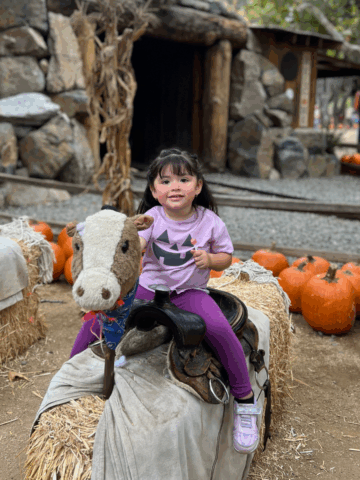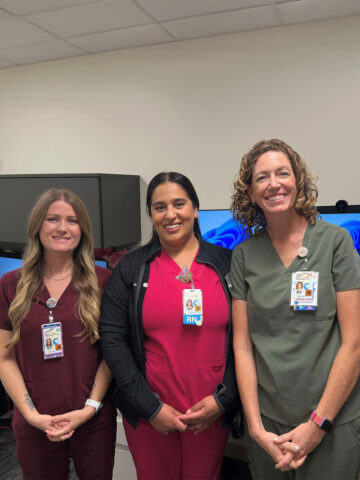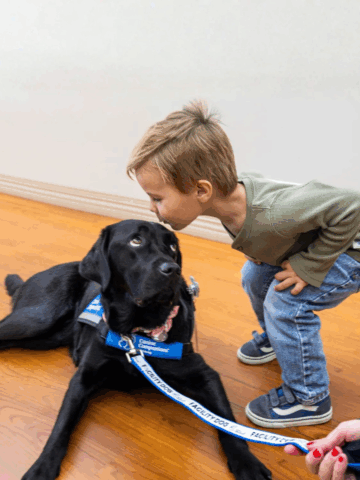The Cherese Mari Laulhere Child Life Department at CHOC strives to normalize the hospital environment for patients and families. “Normalizing” the hospital experience means making things like medical equipment and procedures feel less strange or foreign. By doing this, patients and families can feel more at ease while at the hospital and will be able to focus on what is most important: feeling better.
But just because we’re a children’s hospital, doesn’t mean we only treat little kids. CHOC child life specialists work with teen and young adult patients, too. Follow along for a day in the life of Karlie, an oncology child life specialist.
6:00 a.m. – My alarm goes off and I quickly push snooze. I lay in bed for a bit longer as I am still trying to master the art of getting out of bed as soon as the alarm tells me to. After a few more moments of relaxing I get up, ready to take on the day. I get ready, make some breakfast, pack my lunch and my workout clothes, and head out the door by 7 a.m. to get to work on time.
8:00 a.m. – After making it through infamous Southern California traffic, I arrive at work. During my drive, I usually listen to some sort of motivational worship talk or devotional and once I park, I say a quick prayer to help me be ready for the day. I walk into my office and greet my fellow child life specialists. The office is full of smiling faces, and despite the early hour, it’s already bustling with colleagues talking about various patients and their needs. I work on the hematology/oncology unit, but we have child life specialists embedded in practically every unit and area of the hospital. Our team is filled with energetic, gracious and positive people trying to provide the best support possible to the patients and families that we serve. I feel so grateful and able to take on the day with them by my side.
8:15 a.m. – To start the day, I get a copy of the patient census—an overview of the current patients admitted to the hem/onc unit. I also check the surgery schedule to know what surgeries or procedures my patients have that day.
8:30 a.m. – I head to a meeting with the oncology multidisciplinary team which consists of the medical and psychosocial team. We discuss various patients and their plans of care. We also discuss what psychosocial needs have already been met and what support they still need. We make sure to communicate with each other so that as a team we can ensure we’re meeting our patient’s physical, emotional, spiritual and mental health needs.
10:00 am – I head up to the hem/onc unit and check in with the bedside nurses, so I know what the plan for the day is for each of the patients that are on the unit. We discuss how we can work together to best help each patient. I talk to one nurse about a 17-year-old patient that was just admitted last night with a new diagnosis of leukemia. She tells me that he is feeling nervous about a procedure he’s scheduled for later that day. We go over my plan to support him and I tell her I will keep checking in and keep her updated with how the patient is feeling. I then go into his room and introduce myself and tell his family more about what child life has to offer in terms of “normalizing” the hospital environment. We also talk about what he likes to do, his favorite sports teams and who makes up his family. After we have built some rapport and trust, we talk about his upcoming procedure and I explain it in a way he’ll understand, and it helps ease his anxieties. We talk about why the doctors want him to get some tests done and what these tests will tell the doctors. We talk about the roles of each staff member he will meet, and how they will help him. We set up a hospital tour for later that day. In the meantime, I call my volunteers to drop off a soccer Xbox video game for him to play in his room while he waits.
10:30 a.m. – I get a call to come and help one of my long-time patients with her port access. A port is a medical device surgically placed under the skin in the chest that can be accessed with a needle for infusions and lab draws. When she was first admitted, we worked on coping techniques including medical play, and now she doesn’t get as anxious for procedures. She’s been in treatment for six months, but she still prefers me to be there, and I enjoy seeing her and being there for her. We play her favorite iPad game together while the nurse does the procedure. During the procedure I remind her of each step of the process as it comes, to help her feel empowered and ready. During the needle poke, we do deep breathing exercises together to breathe away any pain or discomfort, and she squeezes my hand. As soon as the poke is done we go back to playing on the iPad and laughing at inside jokes we’ve developed over the last few months. I applaud her for how well she has been doing with her port needle accesses and tell her how proud I am of her.
11:00 a.m. – I take the time to check in on some more patients that I know, and make sure they have everything they need for the day, including some fun activities to look forward to. A few of my longtime patients are in the middle of long hospital stays, so I come up with a plan for something fun and different for them to do that day to help make the most of every day they are there.
11:30 a.m. – I check in on my new 17-year-old patient and find that he is ready for his tour. We start by walking around the hem/onc unit and I show him the gym and the teen room. He loves air hockey, so I show him the air hockey table in the playroom as well. On our tour, we cross paths with a pet therapy dog, so we stop to spend some time with him, and we all laugh as the dog does one of his famous tricks that he has practiced for a doggy treat. We then head down to the second-floor lobby to check out the amenities it has to offer. We check out Seacrest Studios (our in-house radio station), the movie theater, another teen room, Turtle Talk, and two outdoor patios. Child life organizes a lot of special events for patients, and today we are hosting several baseball players from the Angels. We stop by that event while we’re on the second floor and check out the games going on, crafts, giveaways and my patient snags a few photos with his favorite players before I escort him and his family back up to their room.
12:00 p.m. – I take time for a quick lunch break with my fellow child life specialists. I work with some of the kindest, strongest, most giving and selfless people that I know. We enjoy some great conversation about work and about our lives outside of work. My coworkers are my greatest support on the job and I feel grateful to be able to work alongside them and the other wonderful staff at CHOC. I am thankful every day for the wonderful coworkers I have that are also some of my closest friends!
1:00 p.m. – I head back up to the 5th floor to take part in one of the best parts of my job. Today we’re celebrating the final chemotherapy treatment of a 22-year-old patient. I have a trophy and a sign that reads “Happy Last Chemo!” I gather the nurses, clinical assistants, nurse practitioners, and any other available staff to join in. We parade into the patient’s room cheering, and sing the “Happy Last Chemo” song to the tune of “Happy Birthday.” As I look around the room, I see that the patient, her family, and all the staff have tears of joy in their eyes. We are so happy for this patient reaching the end of her treatment. This is definitely something worth celebrating.
2:00 p.m. – I get a call from the front desk that some special visitors are waiting for me. I know it is the surprise we have in place for another patient. This patient, a 13-year-old girl, has been in the hospital for a while and I know she could definitely use an emotional boost. Today is her golden birthday, which is the perfect time for a big surprise. I reached out to a local jewelry store and asked for their help. They agreed to bring some cute gold jewelry items for this patient to help celebrate her golden birthday. I feel so grateful for our community partners that are so generous and willing to help our patients. Seeing my patient’s face light up warms my heart. She knows that she was thought of individually and that people wanted to make her day brighter. I am so grateful to be able to help provide these special and meaningful experiences to a patient like her that is so kind, strong, and such an example of perseverance.
2:30 p.m. – I return to the room of my 17-year-old patient and take him down to the pre-operative unit for his scheduled procedure. We talk about new questions and concerns that he has thought of since this morning, but we also talk about the things in his life that are important to him; his friends, family, sports, school, and fast food. When it’s go-time, I stay with him as his parents go wait in the lobby. Before he receives anesthesia, I stay with him as we listen to his favorite artist and talk about what songs he likes. I’m a terrible singer, but we sing together to take his mind off the procedure. We continue doing this while the wonderful team of nurses, technicians, physicians and anesthesiologists get everything ready. The patient and I continue to talk, and I interject every once in a while, to let him know what the procedure staff is doing as we go along. It is time for him to receive his anesthesia and I talk with him until he falls asleep. Afterwards I thank the procedure room staff and doctors for all that they do and I exit the room for the procedure to begin.
3:00 p.m. – Afterwards I head back up to the hem/onc unit for a planning meeting for our biggest event of the year. Each year, the CHOC Oncology Ball presented by The J. Willard and Alice S. Marriott Foundation is a chance for oncology patients and their friends to celebrate their life and all they’ve been through. This event is part of the Adolescent and Young Adult (AYA) treatment program. Our team spends months planning this event so that every patient, no matter their age, can feel like Prom King or Queen for the day.
4:00 p.m. – After that brainstorm meeting, I check in on the family of a newly diagnosed 2-year-old boy. As I enter the room I see that the patient is napping but that his big sisters have come to visit. I talk with the siblings and educate them about what they see in the room and help them understand their younger brother’s diagnosis through a medical play activity. I help them understanding what the nurses and doctors are doing to help him get better. We talk about how they are feeling and concerns and fears that they have. One sister thinks this diagnosis happened because she once got really mad at her brother for taking her toy. I assure her that her brother’s cancer is nobody’s fault, and that there is nothing anyone did wrong that made this happen. We talk about how they can help their brother while he is in the hospital. They can play with him, draw him pictures, give him hugs, wash their hands so he doesn’t get germs, and help mom and dad around the house. I want them to know that as siblings they are important too, and I am here to provide support to them as well. I remind them that every fun thing in the hospital is for them too! With their parents’ permission, I take them down to Seacrest Studios to hang out with the staff there. Seacrest Studios music and programming is broadcast to every patient’s room, and the girls get to help host the daily game of Bingo. To see them feel special and get the attention they need warms my heart. Illness really does affect the whole family and taking the time to acknowledge and be there for each family member is so important.
5:00 p.m. – After leaving the siblings in the excellent care of the staff in the Seacrest Studios I head back to my office to gather my things and head home for the day. On my drive, I call my mom who lives in Utah. I talk to my mom about my day as much as I can without breaking patient confidentiality. I enjoy talking to my parents and know they will always give me sound advice. My mom hands the phone over to my youngest brother, who is a senior in high school and we catch up on his day. I love hearing about my siblings’ lives. I am one of ten children!
5:30 p.m. – I arrive at the gym for my workout. Exercise is a great time to decompress from the day and relieve any stress I may be feeling from whatever sad or difficult situation that may have happened that day. I absolutely love my job, but it can be hard to watch these patients and families go through such difficult things― patients feeling sick, losing their hair, hearing that their cancer came back, having to get a poke for blood, and the reality of sometimes losing a patient to cancer, all takes a big toll on our staff. In addition to support from my colleagues, I also try to find things outside of work that help me cope, and working out is one of those things. Today was not one of those really difficult days, but running on the treadmill and doing some weight training definitely helps me decompress and transition out of work.
6:30 p.m. – I head home and make dinner while I talk to my roommates. We talk about our days and then we have friends come over for a fun game night. It is a great night spent relaxing and connecting with friends.
10:00 p.m. – Time for bed so I can give tomorrow all the energy it needs! I count my blessings, especially being able to spend every workday with the most amazing kids, teens and young adults who are fighting their illnesses with grace, positivity, joy, strength, wisdom and the desire to make the most of every day. I look forward to tomorrow, and the opportunity to offer each patient and family member I come across my best care and support to make their day even a little bit brighter.




